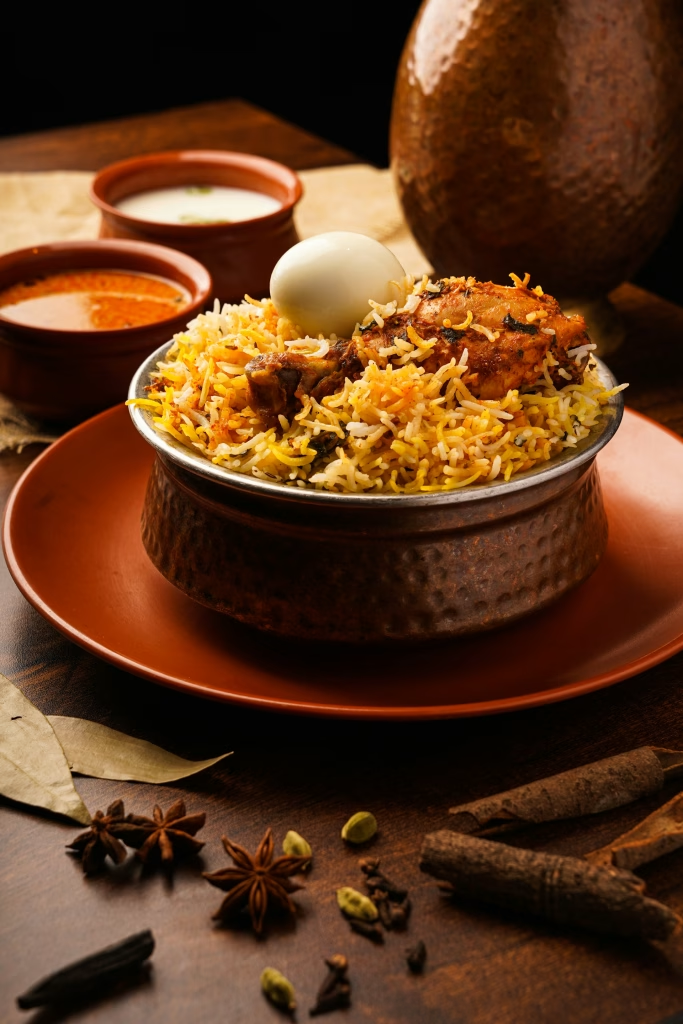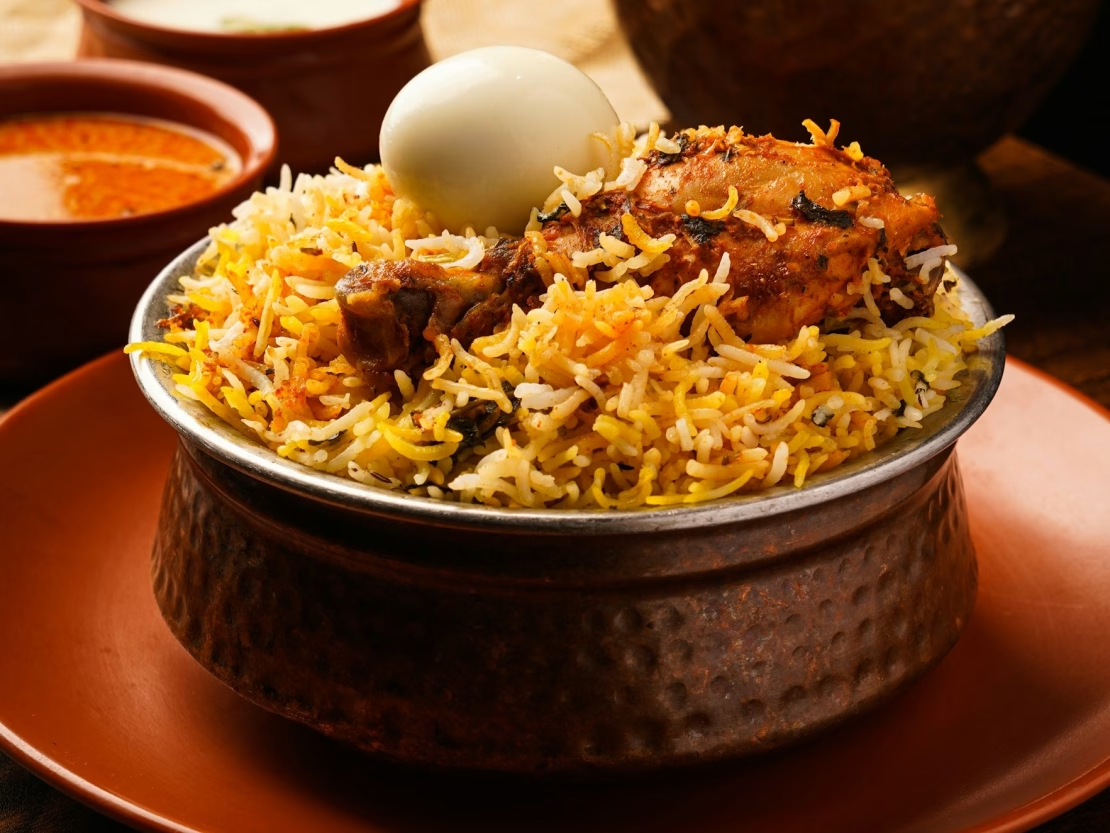Chicken Biryani is more than just a dish, it’s a legacy passed down through centuries of culinary evolution in the Indian subcontinent. Known for its exquisite layers of fragrant rice, spiced chicken, and aromatic herbs, Chicken Biryani is a staple at weddings, festivals, and family gatherings. Loved by millions around the world, it represents a perfect balance of flavor, aroma, and texture in a single pot.
This guide provides a comprehensive Chicken Biryani recipe, including expert tips, variations, a brief history, and answers to the most common questions about this timeless dish.
Table of Contents
Ingredients
For the Chicken Marinade:
- 1 kg chicken (preferably bone-in pieces)
- 1 cup thick yogurt (curd)
- 2 tablespoons ginger-garlic paste
- 1 tablespoon red chili powder
- 1 teaspoon turmeric powder
- 1 tablespoon biryani masala or garam masala
- Juice of 1 lemon
- Salt to taste
- A few mint and coriander leaves (optional)
For the Rice:
- 2.5 cups basmati rice (aged, long-grain)
- 5 cups water (for boiling)
- 1-2 bay leaves
- 4-5 cloves
- 3-4 green cardamoms
- 1 black cardamom (optional)
- 1 cinnamon stick
- 1 teaspoon salt
For the Biryani Layering:
- 3 large onions, thinly sliced
- 2 tablespoons ghee
- 4 tablespoons oil
- A pinch of saffron soaked in 2 tablespoons warm milk
- 1/4 cup fresh mint leaves
- 1/4 cup chopped coriander leaves
- 1/4 cup fried cashews and raisins (optional)
- 2-3 tablespoons rose or kewra water (optional)
Serves
This recipe serves 6 to 8 people.
Step-by-Step Instructions
Step 1: Marinate the Chicken
- Clean and pat dry the chicken pieces.
- In a large bowl, mix yogurt, lemon juice, ginger-garlic paste, chili powder, turmeric, garam masala, salt, and fresh herbs.
- Add chicken and coat thoroughly.
- Cover and marinate in the fridge for at least 1 hour (ideally overnight for best flavor).
Step 2: Prepare the Rice
- Wash basmati rice in water until the water runs clear.
- Soak the rice for 30 minutes.
- In a large pot, boil water with whole spices and salt.
- Add soaked rice and cook until 70–80% done (the grains should be firm but not fully cooked).
- Drain and set aside.
Step 3: Fry the Onions
- In a large pan, heat oil and ghee.
- Add sliced onions and fry on medium heat until golden brown and crispy.
- Remove half for layering; keep the rest in the pan for the chicken.
Step 4: Cook the Chicken
- In the same pan with remaining onions, add the marinated chicken.
- Cook on medium heat until the chicken is 80–90% done and the masala thickens.
- If needed, add a splash of water. Do not dry out the gravy completely.
Step 5: Layer the Biryani
- In a heavy-bottomed pot or handi, start layering:
- First layer: Half of the chicken masala
- Second layer: Half of the rice
- Third layer: Some fried onions, mint, coriander, saffron milk, and rose/kewra water
- Repeat with remaining chicken and rice
- Finish with herbs, saffron, and fried cashews/raisins if using
- Cover tightly with a lid or foil.
Step 6: Dum Cooking (Final Steaming)
- Place the pot on a hot tawa (griddle) to avoid direct heat.
- Cook on low flame for 25–30 minutes.
- Let it rest for 10 minutes before opening.
- Gently fluff the biryani before serving.
Serving Suggestions
- Main accompaniment: Serve with raita (yogurt with cucumber or onion), salan (Hyderabadi peanut curry), or simple plain curd.
- Side dishes: Boiled eggs, papad (crispy lentil crackers), and kachumber salad (onion-tomato-cucumber).
- Drinks: Lassi, chilled soda, or buttermilk to balance the richness.
- Dessert: A sweet like Gulab Jamun or Kheer pairs beautifully post-meal.
Tips for Perfect Chicken Biryani
- Use good quality aged basmati rice: It gives the long, fluffy texture Biryani is known for.
- Marinate well: For deep flavor, marinate the chicken overnight.
- Layer with precision: Keep rice and chicken layers distinct.
- Do not overcook rice: 70–80% doneness is key before layering.
- Seal the pot properly: Use dough or foil to lock in steam during dum cooking.
Healthier Alternatives
- Low-oil method: Use less ghee/oil and bake instead of deep frying onions.
- Brown rice: Substituting basmati with brown rice adds fiber but changes the texture.
- Lean meat: Use skinless chicken breast or turkey instead of thighs for less fat.
- Air-fried onions: A healthy swap for deep-fried onions in layering.
- Greek yogurt: Low-fat Greek yogurt for marination cuts down calories.
Creative Variations
- Egg Biryani: Substitute chicken with boiled eggs for a protein-rich vegetarian version.
- Mughlai Biryani: Richer version using cream, saffron, and dry fruits.
- Kolkata Biryani: Includes boiled potatoes and subtle flavors.
- Malabar Chicken Biryani: From Kerala, using short-grain rice and coconut notes.
- One-Pot Pressure Cooker Biryani: Quicker method with less fuss for weeknights.
Common Mistakes to Avoid
- Overcooking the rice: Leads to mushy, broken grains during dum.
- Too much yogurt in marinade: Can make the chicken watery.
- Layering when rice is hot and wet: Can steam the dish instead of dum cooking.
- Not sealing the pot well: Allows steam to escape, drying the biryani.
- Using cold saffron milk: Always warm it for best infusion and color.
History of Chicken Biryani
Royal Origins
The origins of Biryani can be traced back to Persia, but it found a luxurious home in India during the Mughal era. The word ‘Biryani’ comes from the Persian ‘birian’ (to fry before cooking) and ‘birinj’ (rice). It is believed that Mughal emperor Shah Jahan’s wife, Mumtaz Mahal, once asked her chefs to prepare a wholesome and flavorful rice dish for soldiers—thus biryani was born in its earliest Indian form.

Evolution Across Regions
As the dish traveled through India, it absorbed regional flavors and methods. The Hyderabadi version uses the ‘kacchi’ (raw meat) method while Lucknowi (Awadhi) biryani relies on the ‘pakki’ (pre-cooked) method. From the aromatic Kerala Malabar version to the mildly spiced Kolkata biryani, each region has given Chicken Biryani its own distinct character.
Modern Global Popularity
Today, Chicken Biryani is a symbol of celebration, found on menus from five-star hotels to home kitchens. It’s a festival staple and a must-have at Indian weddings. Thanks to the global diaspora, Chicken Biryani is now relished from Dubai to London to Toronto, making it one of the most beloved rice dishes worldwide.
FAQs about Chicken Biryani
- Can I use boneless chicken in biryani?
Yes, but bone-in chicken retains moisture better and adds more flavor. - What rice is best for biryani?
Aged long-grain basmati rice is ideal for its aroma and texture. - Can I make biryani without marination?
It’s not recommended—marination ensures tender and flavorful meat. - How do I store leftover biryani?
Cool completely, refrigerate in an airtight container, and reheat gently. - Can I cook biryani in a rice cooker?
Yes, but it may not produce the traditional layered texture or aroma of dum cooking. - How do I prevent biryani from being too dry?
Make sure your chicken has some gravy and don’t overcook the rice. - Is Chicken Biryani spicy?
It depends on the recipe. You can adjust chili levels to taste. - What’s the difference between pulao and biryani?
Pulao is a simpler dish where rice and meat cook together, while biryani involves layering and dum cooking. - Can I make biryani with other meats?
Yes! Lamb, beef, prawns, and even jackfruit are popular biryani variations. - How long should I cook biryani on dum?
About 25–30 minutes on low heat is ideal for perfect flavor fusion.
Chicken Biryani is not just a recipe, it’s an experience. Rich in flavor, steeped in history, and beloved by food lovers across generations, it’s a dish that brings people together. From weddings to weekend feasts, its irresistible aroma and layered beauty make it a showstopper every time.
Whether you’re a first-time cook or a seasoned biryani lover, this guide ensures you master the art of making authentic Chicken Biryani at home. With endless regional tweaks and variations, you can continue to experiment and make it your own.


